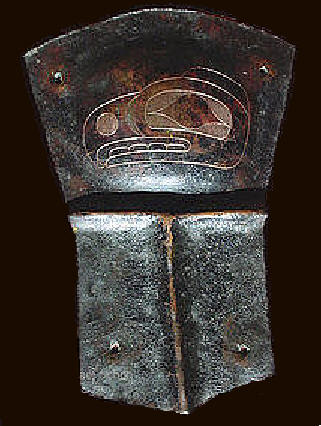
Below is the text of an advertizement for the sale of this copper by an "art" dealer in Florida.
This important copper shield currency (known as a 'tinnah' or 'taus') comes from the Cross family, a very well known family of Haida carvers. John Cross was born around 1850 and died around 1936. He was a contemporary of Charles Edenshaw - they were business partners and both from the village of Skidegate on Graham Island in the Queen Charlotte Islands (Haida Quai). These men were known as the "Eagle fugitives" (they were Eagle clan as are most traditional residents of Haida Quai) because their work was so sought after they had to "run from all the commissions they were being offered." John was a carver of totem poles and masks. His son, Raymond, was a carver and leather worker and his son, Nelson, is a maker of fine N.W. Coast jewelry. This copper was purchased from Nelly Cross, Raymond's widow. It has been in the Cross family in an unbroken line of succession, originally retrieved from an old totem when John Cross returned to Skidegate after the Canadian government mandated evacuation of many villages that had been ravaged by disease. Additionally, many coppers were confiscated by the Canadian government in the late 19th century after a ban was placed on the potlatch ceremony. The eagle totemic symbol was incised by Nelson Cross ca. 1980. He felt that the copper should carry his family crest as it had been in his family since it was acquired by John Cross sometime in the 1890's. Nelson is famous in his own right as a maker of Haida jewelry- his excellent workmanship is reflected in the engraved image on the rare copper. This Haida "hard" copper was used as a marker and passed along as a symbol of wealth among Haida clans. Wealthy Haida chiefs were known to have as many as a dozen coppers at any one time. The standard evaluation for a copper was in thousands of blankets, and it is documented that one large copper owned by Albert Charles Edenshaw was once traded for 8 slaves, one large canoe, 100 elk skins and 80 boxes of grease! The thickness of the copper where the "T" (which is called "taow-tsoe-h" or backbone of the taow" or ancestor) was formed is the same as the rest of the copper - this is critical in assessing the veracity of the copper as many so-called "spurious" coppers were made by people who didn't have the training or traditional understanding of the craft, resulting in a thinner copper from being pounded at the 'T'. The edges are rough cut - as if cut with an iron tool - rather than sheared or sawn away. The upper section is, appropriately, ballooned-out, and the holes were punched-through rather than drilled. Copper fragments on the back sides of the holes can be seen where the metal was pushed aside by the punch. Measuring 11.50"L x 7.75" W, the currency is intact and is covered in a thick coating of black pitch paint, typical of the oldest 19th C. forms.
